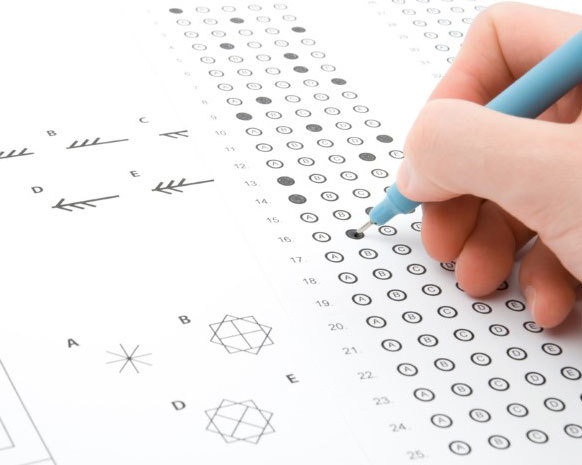
السلام عليكم ورحمة الله وبركاته
هذا اختبار بسيط لكل المهندسين المبتدئين سواء خريجين او طلبه فى قسم القوى والالات الكهربية وارجو من الجميع عدم الاستهتار والتهاون وحاول تختبر نفسك وشوف مستواك فى اساسيات الكهرباء
-
In a synchronous motor the field revolves:
i) Exactly in step with the rotor.
ii) In front of the rotor.
iii) Behind the rotor. -
If an actuator brake coil is open-circuited the actuator will:
i) Run at reduced speed.
ii) Overrun.
iii) Stop. -
The correct electrolyte for a lead acid battery is:
i) Potassium hydroxide.
ii) Lead peroxide.
iii) Sulphuric acid. -
A Ni-Cad battery consists of 19, 1.2 volt cells. What will the nominal battery output be?
i) 20 V
ii) 22 V
iii) 24 V -
The correct neutralizing agent used in a lead acid battery is :
i) Bicarbonate of soda.
ii) Potassium hydroxide.
iii) Water. -
The preferred method of battery charging a Ni-Cad battery is:
i) Const. voltage.
ii) Const. current.
iii) Const. speed. -
The output of a DC. generator is controlled by varying the:
i) Engine speed.
ii) Armature current.
iii) Field current. -
The output of a light A/C’s alternator is:
i) A DC. Voltage.
ii) Single phase AC.
iii) 3 phase AC. -
The 3 phase voltage generated within an alternator is converted to DC. by:
i) The voltage regulator.
ii) The rotating diodes.
iii) The armature. -
The generator output can be measured by using:
i) A voltmeter.
ii) An ammeter.
iii) A tachometer. -
The CSD ensures that:
i) The engine speed remains const…
ii) The generator is adequately cooled.
iii) The generator speed remains const. -
Which of these factors affecting the output voltage of a DC. generator is normally controlled?
i) Field current.
ii) The number of conductors in the armature.
iii) Generator speed. -
In a carbon pile regulator the core resistance is varied by:
i) A spring.
ii) Generator load current.
iii) Electro-magnetic force. -
Generator load sharing is applicable to:
i) AC. and DC. Generators.
ii) AC. generators only.
iii) DC. Generators only. -
In an AC. generator SYS, reactive load sharing is achieved by controlling:
i) Generator speed.
ii) Generator field current.
iii) Generator current. -
Real load is measured in:
i) Watts.
ii) Volt amps.
iii) Joules. -
Output voltage levels from a rotary inverter are controlled by:
i) Varying the speed of the DC. Motor.
ii) Adjustment of the output voltage of each phase.
iii) Varying the generator field excitation current. -
The output frequency of an inverter is controlled by:
i) Varying the speed of the DC. Motor.
ii) Varying the generator field current.
iii) Switching the DC. Supply. -
The output voltage is measured by:
i) An ammeter.
ii) A voltmeter.
iii) An annunciator. -
Static inverters are usually employed to provide :
i) Emergency power to essential loads.
ii) Continuous power to flight instruments.
iii) Emergency power to instruments in the event of inverter failure. -
The output frequency of a static inverter is:
i) 50 Hz.
ii) 400 Hz.
iii) 1500 Hz. -
The number of circuits which can be completed through the poles of a switch is identified by the term:
i) Toggle.
ii) Throw.
iii) Position. -
A relay with a moving core is usually known as a:
i) Solenoid.
ii) Polarised relay.
iii) Proximity switch. -
In a moving coil meter, the coil is wound on to:
i) A permanent magnet.
ii) Part of the control springs.
iii) An iron core, which is pivoted. -
What is the colour of a warning light?
i) Red.
ii) Amber.
iii) Blue. -
How is an ammeter connected to measure generator load?
i) In parallel with the load.
ii) In an open circuit with the load.
iii) In series with the load. -
Larger sizes of aluminium cables when installed:
i) Save weight.
ii) Are more reliable.
iii) Use less space. -
Which is the largest wire size for A/C use?
i) 40 AWG.
ii) 1 AWG.
iii) 00 AWG. -
Crimped terminals are more satisfactory because:
i) Special tools are not required.
ii) Conductor flexibility is retained.
iii) A skilled engineer must carry out the crimp. -
Attachment of conductors to pin and socket contacts is mainly done by:
i) Crimping.
ii) Soldering.
iii) Adhesive.
32) Aluminium conductors are terminated with lugs made from:
i) Copper.
ii) stainless steel
iii) Aluminium copper alloy.
منتدى المهندسين
مهندس وائل خطاب